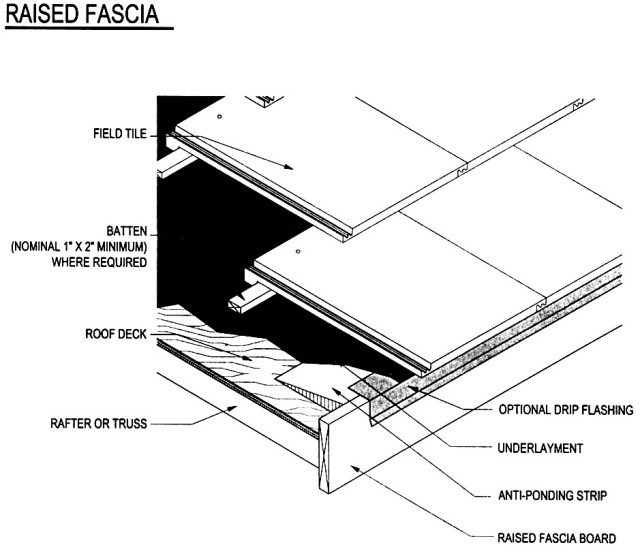
If your home inspection report mentions a “missing anti-ponding provision” on your tile roof, you’re probably wondering what that means and if you should be worried.
In short, it’s about how your roof drains water. A missing anti-ponding provision means there’s nothing in place to stop rainwater from pooling near the roof’s edges. That small detail can lead to significant issues if ignored, such as leaks, rot, and even early roof failure.
What Does Ponding Mean
Ponding is just a fancy word for standing water on a roof. If rainwater sits in one spot for more than 48 hours after the weather clears, it’s considered ponding.
Tile roofs are water-shedding systems. They’re designed to let water run off, not hold it. So, if your roof has dips or missing drainage components, that water has nowhere to go. Over time, that standing water seeps under tiles, damages the underlayment, and can cause leaks or rot.
Why Anti-Ponding Boards and Flashing Are So Important
Your roof’s edge, or eave line, is where most ponding problems start. When the fascia board sits slightly higher than the underlayment, it creates a dip right behind the gutter line, the perfect place for water to collect.
That’s where anti-ponding boards (sometimes called anti-ponding strips) come in. They’re thin, durable materials —often metal, wood, or foam —installed under the underlayment at the roof’s edge. The role of this material is to lift the underlayment just enough to let water flow off into the gutter instead of pooling at the edge.
Pair that with anti-ponding flashing —a metal strip that directs runoff away from the fascia and into the gutter, and you have a reliable defense against water buildup.
The Risks of Missing Anti-Ponding Provisions
You might think a little standing water isn’t a big deal. Unfortunately, it can quietly cause long-term damage. Here’s what can happen if the anti-ponding device or board is missing:
Leak and Water Damage
Water that sits for too long seeps under tiles and damages the underlayment. Eventually, it finds its way into your attic or ceiling, leaving stains, peeling paint, and soft spots.
Wood Rot
Moisture buildup near the eaves can cause fascia boards, roof decking, and beams to rot, especially if it happens repeatedly after each rainfall.
Mold and Mildew
Stagnant water encourages mold growth, which can spread into attic insulation and affect indoor air quality.
Shorter Roof Lifespan
Constant exposure to standing water weakens tiles and underlayment faster, leading to cracking, blistering, and premature wear.
Warranty and Insurance Issues
Many roofing warranties exclude coverage for ponding water. If damage occurs due to poor drainage, you may be left footing the repair bill yourself.
How Anti-Ponding Provisions Work
Anti-ponding systems are designed to help water flow smoothly off the roof. They combine design, installation, and materials to make sure rain doesn’t linger where it shouldn’t. The main components of this system are:
- Anti-Ponding Board / Strip: Installed under the underlayment near the eave to raise it slightly.
- Anti-Ponding Flashing: Directs runoff into the gutter and protects the fascia from water intrusion.
- Proper Roof Pitch: Ensures water drains naturally; most tile roofs need at least a 4:12 pitch.
- Underlayment: Acts as a backup waterproof layer if any moisture gets past the tiles.
When installed correctly and inspected regularly, this system works together to keep your roof dry and your home protected.
Common Fixes for Missing Anti-Ponding Boards
If your inspection report says you’re missing anti-ponding provisions, the good news is — you can fix it without a full roof replacement. Here’s how professionals typically handle it:
- Install Anti-Ponding Boards: Roofers can install anti-ponding boards or strips under the underlayment near the eaves. These boards create a smooth slope that helps water drain properly.
- Add Metal Drip Flashing: Install or upgrade anti-ponding flashing to redirect water away from the roof’s edge, reducing pooling and rot risks.
- Re-Pitch or Level Low Areas: If your roof has visible dips or sags, contractors may use tapered insulation or lightweight filler to restore the slope.
- Upgrade the Underlayment: If the underlayment is already damaged from water exposure, replacing it with a high-quality synthetic material can strengthen your roof’s moisture protection.
- Check the Gutters: Oversized gutters, such as 7-inch seamless gutters for tile roofs, ensure water is properly collected and diverted away from your foundation.
How to Prevent Roof Ponding Long-Term
A few proactive steps can save you a lot of hassle and money later:
- Schedule regular roof inspections, especially before and after monsoon season.
- Keep gutters and downspouts clear of debris.
- Watch for signs of sagging or discoloration near the roof’s edge.
- Ask your roofer if anti-ponding boards or flashing were installed when your roof was built or last replaced.
Key Takeaways
A missing anti-ponding provision might sound technical, but it’s a simple issue with serious consequences if ignored. By ensuring your tile roof has proper anti-ponding boards, flashing, and slope, you protect your home from leaks, rot, and long-term damage.
If you’re in the Phoenix area and your inspection report mentions “missing anti-ponding provision,” Advantage Inspection Service can help you understand what’s going on and guide you toward the right solution before it turns into a bigger problem.
Frequently Asked Questions
What exactly does “ponding water” on a roof mean?
Ponding is water that remains on a roof surface for 48 hours or more after precipitation has stopped. This standing water severely degrades the roof’s underlayment and can lead to structural rot and interior leaks.
How can I tell if my tile roof has an anti-ponding provision?
The easiest way is to have a professional roofing contractor or home inspector examine the roof’s perimeter. They look for specific features, such as anti-ponding boards or metal strips installed beneath the underlayment at the eaves, which are designed to create a positive water slope.
What’s the recommended minimum pitch for a tile roof?
Most building codes (IRC) require a minimum pitch of 4 units vertical and 12 units horizontal (4:12) for tile roofs. Slopes below this mandate additional layers of protective underlayment to compensate for the reduced gravity-driven drainage.
Can a missing anti-ponding provision be repaired, or does it require a complete roof replacement?
Often, it can be remedied through targeted repairs. This usually involves installing the necessary anti-ponding boards or specialized flashing at the eave line, or correcting localized low spots without requiring a complete tile tear-off.
How does proper gutter sizing relate to anti-ponding efforts on tile roofs?
Proper sizing is crucial because tile overhang can cause water to overshoot smaller gutters. This overflow leads to pooling at the roof edge and foundation saturation. Larger gutters (7 inches) ensure effective water capture and diversion, preventing ponding.
